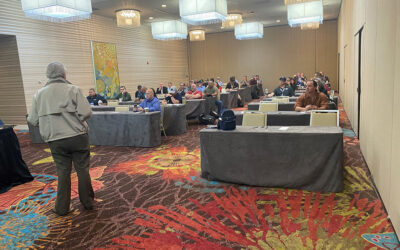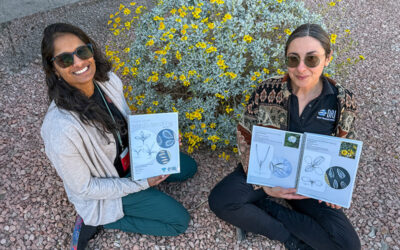Mary Cablk, Ph.D., recently retired from DRI after 23 years. Her journey into science began with remote sensing, and she later pioneered new fields of scientific research by integrating her experience as a canine search and rescue handler and trainer. In addition to her role as an Associate Research Professor in DEES, she served as Graduate and Adjunct Faculty at the University of Nevada, Reno, where she was instrumental to the creation of a Ph.D. program in forensic anthropology.
Among her many career accomplishments, she was the first to use detection dogs to track and locate threatened desert tortoises, as well as the first to establish that dogs can locate human teeth for recovery and identification purposes. She serves on the American Academy of Forensic Sciences Consensus Body and Standards Board, is a court recognized expert on the science of detection dogs, and is an auxiliary deputy with several County Sheriff’s offices in Nevada.
Cablk shared some of her career highlights, her plans for a busy retirement, and her perspective on how the scientific landscape has changed over the years.
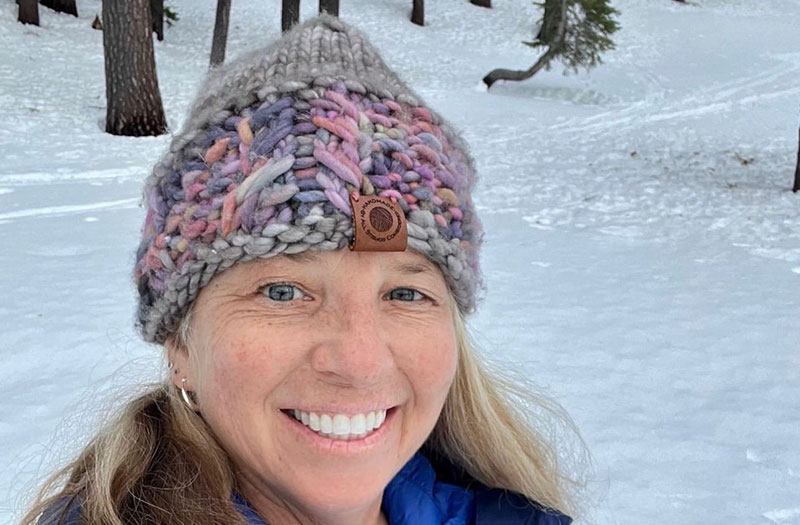
Cablk, who recently retired from DRI after 23 years.
Credit: Mary Cablk/DRI.
DRI: What first brought you to DRI?
Cablk: I met a now retired faculty member, Dr. David Moat, while doing my Ph.D. at Oregon State. He was on loan from DRI and was stationed at the EPA lab in Corvallis, Oregon, at the National Health and Environmental Effects Research Laboratory. He invited me to work on a D.O.D funded project in the California Mojave Desert, so I competed for, and was awarded, a National Research Council Postdoctoral Fellow position, two years in a row. When Moat returned to DRI in Reno during the project I followed to finish out that postdoc, and that’s how I ended up here.
DRI: How did your interest in scientific research begin?
Cablk: I was exposed to satellite imagery and image processing when I was in graduate school at Duke University. I took a course in remote sensing – this was back when times were very different than they are now. We didn’t have smartphones, and we certainly didn’t have imagery on anything handheld. I thought satellite imagery was beautiful.
Art is in my genes — my grandmother was a biological illustrator. If I didn’t go into science, I was going to go into art. I thought the imagery of earth was beautiful, and then it turned out to also be data, so I got sucked into it. Everything about it appealed to me – what you could see from afar – there’s a lot of art in science, if you know how to look for it.
DRI: How did you transition into doing a lot of work with dogs?
Cablk: That started early in my career, around 2001. Right around the time when I was finishing my postdoc here, and I was a new faculty member. A Government Accounting Office report came out examining how much money had been spent on desert tortoise research, which was a lot, and what they had received in return for all that money. It wasn’t much – we weren’t getting any closer to delisting the species or reversing the downward trend.
At that time, I had started doing search and rescue myself with my own dog. I started to see what dogs could do searching for missing people, and I thought, “Wow, this is incredible. I wonder if dogs can find tortoises.” That was really the launchpad for what became a career studying canine detection. It didn’t come easy – I was told initially by a lot of people, “that’s the dumbest thing I’ve ever heard.” Now, of course, wildlife conservation detection is huge. But back then I was one of the first to pioneer interfacing dogs with actual animals, and not just scat. We had some success, and then things snowballed and progressed. Before I knew it, I was 10 years in and a few million dollars into the research.
I would draw from the search and rescue community to hire dogs and handlers for my Desert Tortoise K9 program, because at that time there weren’t many professional handlers like there are now. Conservation canine work is commonplace now, but back then, we were pioneering everything. It was fun – a lot of time spent in the desert, and I spent months and months living outside of military installations. That was a big part of my career.
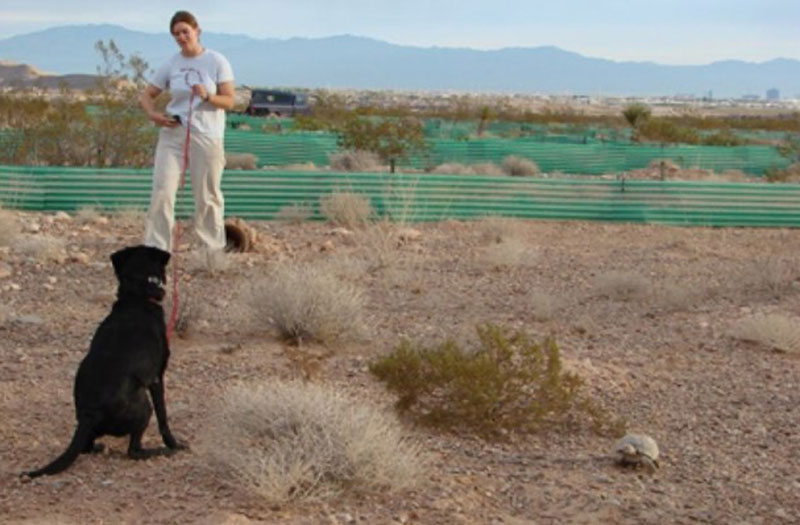
A tortoise detection dog-in-training performs his trained alert, the ‘sit,’ near a tortoise.
Credit: Photo from Cablk et al., 2008, “Olfaction-based Detection Distance: A Quantitative Analysis of How Far Away Dogs Recognize Tortoise Odor and Follow It to Source.”
DRI: I’d love to hear more about your search and rescue work and how you got started with that.
Cablk: I got into it very early on when I was a postdoc. I had someone close to me who needed rescue in Zion National Park, and search and rescue in Zion saved his life. There is some percentage of people who get into Search and Rescue because they have a first-hand experience, or someone close to them needs rescue or recovery. I’m one of them, and it just dovetailed with my wanting to work with dogs. I’d always had dogs, my degree was in biology, and I have a lot of background in animal behavior. I was never a laboratory person.
Search and rescue really opened my eyes to possibilities for research because back then this was all new. Nowadays, we’re in a super exciting time with research into canines, canine behavior and cognition. But back then, it was literally a desert of knowledge and science. So, I just integrated what I was learning from my research into how I was training dogs in search and rescue, and then taking things that we saw on deployments and in training, and turning that around and asking questions to see if we could address those scientifically. So, I’m a little bit unusual – maybe not unusual for DRI, but certainly for a lot of people’s careers – where there’s this integration between what I do professionally and what I do in my free time. It’s been a really fun way to have a career, looking back on it.
DRI: You’re very involved in the local search and rescue groups, right?
Cablk: Yes, very much. When you run dogs for search and rescue, you either do it for a little bit, and then you get out of it quickly, or you’re in it for life – I fall into the latter category.
I’m an auxiliary deputy with the sheriff’s office here in Washoe County, the Carson City Sheriff’s Office, Douglas County Sheriff’s Office, Lyon County Sheriff’s Office, and the Humboldt County Sheriff’s Office. Over in the state of California I’m integrated with their Office of Emergency Services with the Governor’s office there.
Search and Rescue requires a huge amount of time – very few people have the time and the means to be able to do it. I feel very fortunate that I had the wherewithal and the ability to land here at DRI where I could pursue whatever research interests I wanted as long as I could secure funding. We have complete flexibility to be able to integrate something like search and rescue with science. It’s really unique here.
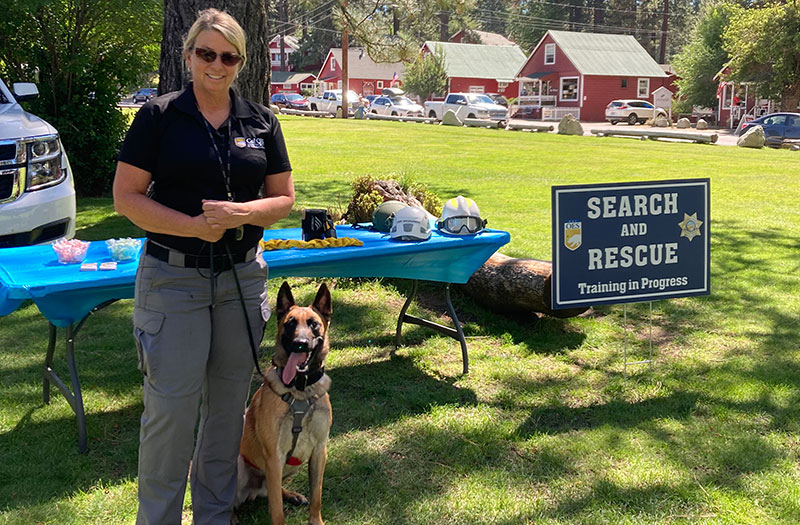
Cablk with her dog, Dax, at a search and rescue training course.
Credit: Mary Cablk/DRI.
DRI: Can you talk about some of your research projects?
Cablk: Well, after I learned about how difficult it was for forensic anthropologists to find teeth (which is important for body identification) I thought “You know, if dogs can find desert tortoises the size of a half dollar in hundreds of acres of desert, I bet they could find teeth.” And I saw a call for proposals that I think the Department of Justice had put out to develop more sophisticated methods to locate teeth. So, I called the program manager to get a little more information and said, “Hey, here’s my idea. I think we should look at running dogs to find teeth.” He said that was the most ridiculous idea he had ever heard. So, I hung up the phone and said to myself, “That’s fine. I’ll find another source of funding and publish the results anyway.” And that’s exactly what I did.
I published the study in the Journal of Forensic Sciences. And I was told that one year the findings were included in the American Academy of Forensic Sciences diplomate exam, which is a big deal. It was groundbreaking research at the time.
DRI: How have things changed since you first started your career?
Cablk: They have changed so much. Probably the biggest part is the development of technology. When I first started working with satellite imagery, we didn’t have the spatial resolution that we have now. I was computer line coding to do my analysis, and now people do analyses on their phones. Cellphone technology had just become smaller than a handheld brick when I finished my PhD in 1997. When we would go out in the field, we didn’t have communications with anybody. And you know, you just did what you had to do to get your research done. We were very creative. And it was fun – it was really fun.
I think for my generation of field scientists who would go out, we would dive in headfirst and get our hands dirty – that’s the fun part. Now, there’s a lot more oversight. And then of course, now we’re in constant communication.
But we also didn’t have the education-communication side of it, to tell the world about what we were doing. That wasn’t really a thing, for lack of a better term. We would communicate within our own discipline, peer to peer and colleague to colleague, but it was difficult to explain to the public what we were doing. I have a million stories about the personal interest side of science and fieldwork, but in my generation, we were never taught how to share those stories. It was not something that was appreciated. I’m proud of the work that I did, and I’d love to share the human side of it. Like the first time the dogs found tortoise hatchlings, which are the size of silver dollars. That ability wasn’t on our radar screen, and we just sat there and watched it happen. It was like watching Neil Armstrong step on the moon – we had no idea that what the dogs were doing was even possible. I wish that we’d had an opportunity and the means to communicate that pivotal finding. Now, I see that shift in DRI and in the scientific community as a whole, towards communicating our science to the public, but back then, it was a whole different environment.
DRI: How has working at DRI impacted your scientific research and network?
Cablk: Well, I think it’s the other way around. I mean, we’re the ones that are doing the research. And we can do it anywhere. I don’t see that DRI has necessarily impacted my work, but I think that DRI has created a tremendous opportunity, and the right framework to allow professional development and growth.
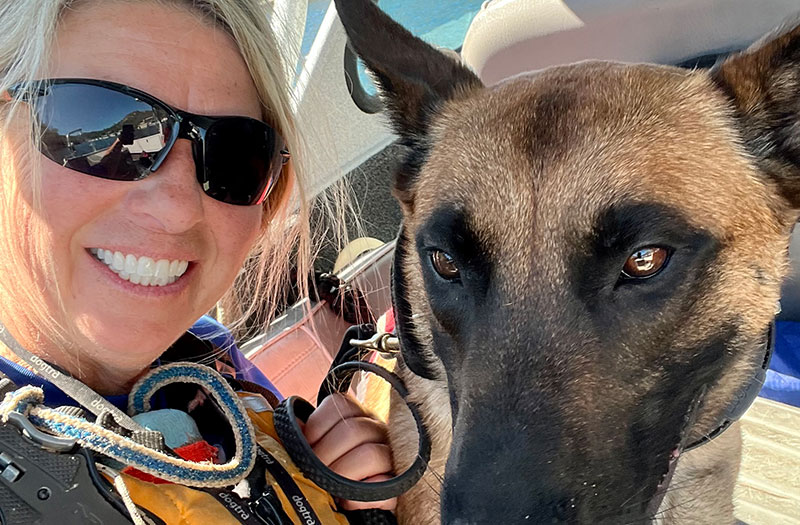
Cablk with her dog, Dax.
Credit: Mary Cablk/DRI.
DRI: What advice do you have for young scientists?
Cablk: The world is so different now. Nowadays, we don’t have the hard lines between disciplines that we did before. I see the world now as an endless sea of opportunity. The one piece of advice that I’ve always given, is when you’re dealing with data analysis software, you need to learn the math behind it, and not just which buttons to push.
Go for it, have fun with it. Life at DRI is incredibly stressful. Now, on the other side looking back, I can’t imagine doing anything else. But it’s a double-edged sword. You have to have the stomach for it, especially as a woman. I do believe that challenges still exist for women, even though we’re in a different society than we were even a decade ago. I don’t know that there’s anything anybody can do externally to help women scientists find their voice and their confidence. I wish I could, because I wish I’d had a mentor like that when I was first starting out. When I showed up here, it was a sink or swim environment. But if you have the brains, and you have the passion, and the drive, and the dedication and motivation – young scientists can do anything nowadays. And they should.
DRI: What are your plans for retirement?
Cablk: Oh, I love retirement! I’m still working. Every day is different and interesting. I am in a teaching role for the state of California Governor’s Office of Emergency Services. I teach search and rescue, having almost 25 years of experience and training under my belt. We do week-long courses for what’s called “Winter Search Management.” We go down to Mammoth Lakes or Mount Shasta or Sequoia Kings Canyon, and teach law enforcement everything about winter searching: avalanche conditions, medical, equipment, you name it. We spend five days and at the end, they end up sleeping in a snow cave that they dug themselves.
I’m also working with Chico State forensic anthropologists and the state of California Office of Emergency Services to develop the canine portion of a new class called “search methods and identification in a burned environment.” So, when we have these massive, fatal fires that are tragic and have become an annual occurrence, we use the dogs to help locate missing people.
And of course, I’m still deploying dogs. I have the freedom and flexibility to deploy on searches and I’m still very active with the American Academy of Forensic Sciences. I still sit on their standards board and we’re working on developing national level standards. I am often invited to speak at professional conferences and meetings, for example I’ll be talking about water recovery canines with the International Water Rescue Professionals Association, MENSA, things like that. I’m still active and engaged with the canine community, and there’s certainly a scientific aspect to my involvement. Someday maybe I’ll end up on a beach, like some of my colleagues who are also retired, but I’m still pretty young and have more professional interests to pursue.
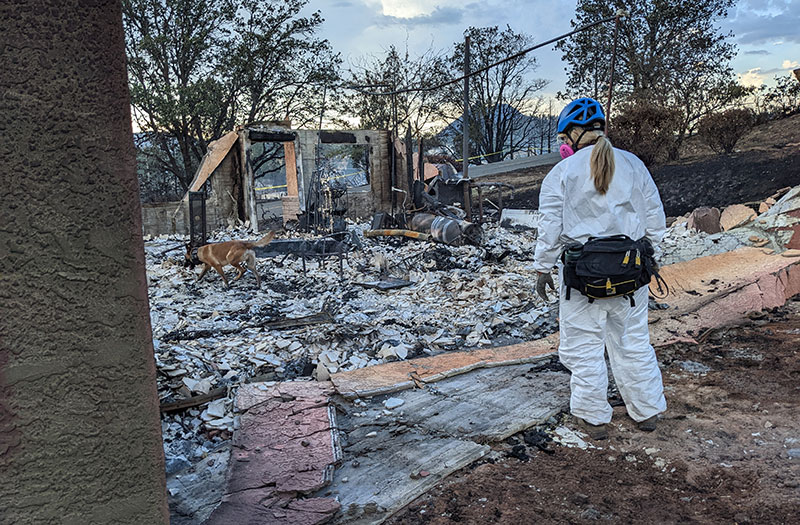
Cablk doing recovery work with her dog, Dax, at a burn site in California.
Credit: Mary Cablk/DRI.
DRI: Will you continue doing some work at DRI?
Cablk: I’ll seek emeritus status, and then become an hourly to be able to take advantage of opportunities that might come through DRI. We have phenomenal scientists here. And I really loved working at DRI. I’m not saying it wasn’t stressful, and I’m not saying it wasn’t hard — but what a great career.
